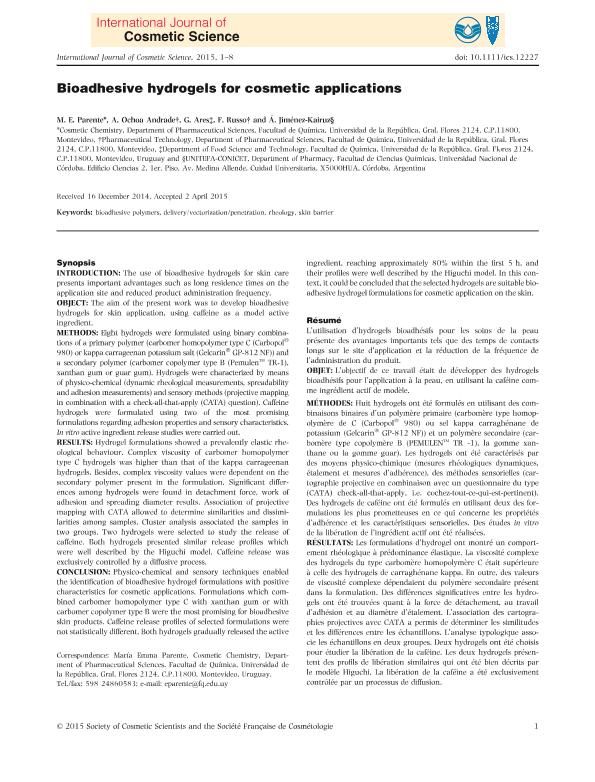Artículo
Bioadhesive hydrogels for cosmetic applications
Fecha de publicación:
10/2015
Editorial:
Wiley
Revista:
International Journal Of Cosmetic Science (print)
ISSN:
0142-5463
Idioma:
Inglés
Tipo de recurso:
Artículo publicado
Clasificación temática:
Resumen
Introduction: The use of bioadhesive hydrogels for skin care presents important advantages such as long residence times on the application site and reduced product administration frequency. Object: The aim of the present work was to develop bioadhesive hydrogels for skin application, using caffeine as a model active ingredient. Methods: Eight hydrogels were formulated using binary combinations of a primary polymer (carbomer homopolymer type C (Carbopol® 980) or kappa carrageenan potassium salt (Gelcarin® GP‐812 NF)) and a secondary polymer (carbomer copolymer type B (Pemulen™ TR‐1), xanthan gum or guar gum). Hydrogels were characterized by means of physico‐chemical (dynamic rheological measurements, spreadability and adhesion measurements) and sensory methods (projective mapping in combination with a check‐all‐that‐apply (CATA) question). Caffeine hydrogels were formulated using two of the most promising formulations regarding adhesion properties and sensory characteristics. In vitro active ingredient release studies were carried out. Results: Hydrogel formulations showed a prevalently elastic rheological behaviour. Complex viscosity of carbomer homopolymer type C hydrogels was higher than that of the kappa carrageenan hydrogels. Besides, complex viscosity values were dependent on the secondary polymer present in the formulation. Significant differences among hydrogels were found in detachment force, work of adhesion and spreading diameter results. Association of projective mapping with CATA allowed to determine similarities and dissimilarities among samples. Cluster analysis associated the samples in two groups. Two hydrogels were selected to study the release of caffeine. Both hydrogels presented similar release profiles which were well described by the Higuchi model. Caffeine release was exclusively controlled by a diffusive process. Conclusion: Physico‐chemical and sensory techniques enabled the identification of bioadhesive hydrogel formulations with positive characteristics for cosmetic applications. Formulations which combined carbomer homopolymer type C with xanthan gum or with carbomer copolymer type B were the most promising for bioadhesive skin products. Caffeine release profiles of selected formulations were not statistically different. Both hydrogels gradually released the active ingredient, reaching approximately 80% within the first 5 h, and their profiles were well described by the Higuchi model. In this context, it could be concluded that the selected hydrogels are suitable bioadhesive hydrogel formulations for cosmetic application on the skin.
Archivos asociados
Licencia
Identificadores
Colecciones
Articulos(UNITEFA)
Articulos de UNIDAD DE INVESTIGACION Y DESARROLLO EN TECNOLOGIA FARMACEUTICA
Articulos de UNIDAD DE INVESTIGACION Y DESARROLLO EN TECNOLOGIA FARMACEUTICA
Citación
Parente, M. E.; Ochoa Andrade, A.; Ares, G.; Russo, F.; Jimenez Kairuz, Alvaro Federico; Bioadhesive hydrogels for cosmetic applications; Wiley; International Journal Of Cosmetic Science (print); 37; 5; 10-2015; 511-518
Compartir
Altmétricas




